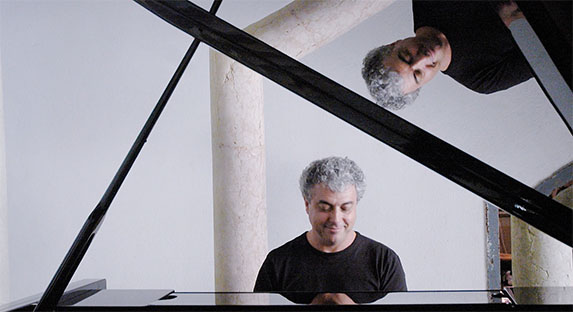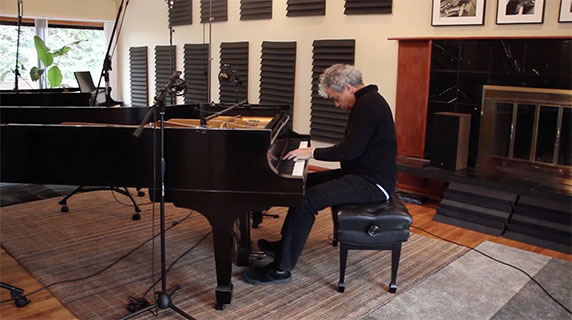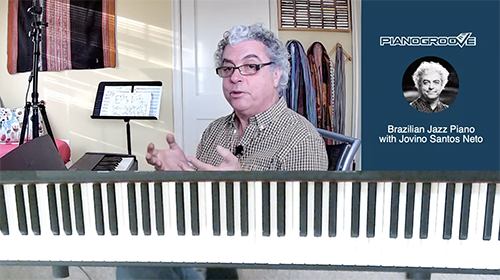
Jovino Santos Neto
Three-time Latin Grammy nominee Jovino Santos Neto, a master pianist, composer and arranger, is among the top Brazilian musicians working today.
Live Seminar Resources
Live Seminar Resources
PDF Downloads
- Outra Vez Chord Chart
Join PianoGroove Pro to access all downloads and learning resources.
Download theory supplements, midi files, chord changes and full note-for-note transcriptions of every lesson.
- Brigas Nunca Mais Chord Chart
Join PianoGroove Pro to access all downloads and learning resources.
Download theory supplements, midi files, chord changes and full note-for-note transcriptions of every lesson.
Related Lessons
Forum Threads
Seminar Description
Seminar Description
Introduction to Bossa Nova for Beginners
Welcome to this beginner-friendly workshop on Bossa Nova piano. In this lesson, we explore the essence of Bossa Nova, its rhythmic foundations, and its harmonic characteristics. Whether you are new to jazz piano or looking to expand your repertoire, this lesson will help you understand how to play and interpret Bossa Nova with authenticity and confidence.
What is Bossa Nova?
Bossa Nova is more than just a musical genre; it is a unique approach to playing and interpreting music. Originating in Brazil in the late 1950s, it evolved as a softer, more intimate style of Samba, often characterized by a relaxed groove, syncopated rhythms, and sophisticated harmonies.
Unlike jazz, where harmonies often arrive late (back-phrased), Bossa Nova anticipates its harmonic changes, meaning chords are frequently played slightly ahead of the beat. This gives Bossa Nova its signature laid-back yet rhythmic flow.
Basic Bossa Nova Groove
The foundation of Bossa Nova lies in its rhythmic pattern. The left hand typically plays a bassline that mimics the surdo drum in Samba, emphasizing beats 1 and 3. The right hand plays syncopated chords, imitating the characteristic guitar strumming pattern pioneered by João Gilberto.
A simple Bossa Nova rhythm follows this structure:
- The left hand plays a steady, relaxed bassline.
- The right hand anticipates chord changes with syncopation.
- The feel is smooth and flowing, not choppy or overly percussive.
Practicing slowly and feeling the groove with a gentle side-to-side motion helps to internalize the rhythm.
Harmonic Progressions in Bossa Nova
Bossa Nova often features lush, jazz-influenced harmonies, including:
- Major 7th, minor 7th, and dominant 7th chords.
- Diminished passing chords for smooth voice leading.
- Tritone substitutions and chromatic movement.
For example, in the tune Outra Vez by Antonio Carlos Jobim, the first four chords are:
Cmaj7 → Eb°7 → D-7 → G7b9
This descending motion, along with voice leading techniques, creates the rich harmonic color characteristic of Bossa Nova.
Syncopation & Melody Interpretation
Bossa Nova melodies are highly syncopated, often starting off the beat or being subtly delayed. Unlike classical music, where the melody is strictly played as written, Bossa Nova allows for a flexible, conversational approach.
A key aspect of playing Bossa Nova well is to:
- Avoid rigid phrasing—let the melody breathe naturally.
- Maintain a soft, smooth touch, especially in the right hand.
- Subtly embellish the melody with chromatic passing notes or grace notes.
Practicing with a shaker or lightly tapping 16th-note subdivisions helps develop the internal rhythmic feel necessary for authentic phrasing.
Applying the Concepts: Brigas Nunca Mais
Another tune covered in this lesson, Brigas Nunca Mais, demonstrates common Bossa Nova harmonic movements, including:
- Descending basslines (Bbmaj7 → A7alt → G-7).
- Substituting dominant chords with minor 6th chords (C-7 → Ab-6).
- Using altered dominant chords for smooth transitions.
This tune is a great study piece for combining Bossa Nova groove with lyrical melodic phrasing.
5 Practice Tips for Bossa Nova Piano
- Internalize the Groove – Practice the left-hand bass pattern independently before adding syncopated right-hand chords.
- Anticipate the Chords – Play chord changes slightly ahead of the beat to capture the authentic Bossa Nova feel.
- Use Smooth Voicings – Prioritize close-position voicings and guide tones for seamless transitions.
- Develop a Three-Gear Rhythm – Feel quarter notes, eighth notes, and 16th notes to enhance your rhythmic flexibility.
- Play Melodies Expressively – Experiment with rhythmic displacement and subtle phrasing rather than playing strictly as written.
By mastering these techniques, you’ll develop a deeper understanding of Bossa Nova and be able to play it with confidence and musicality.
Happy practicing! 🎶






